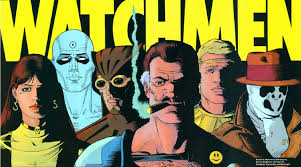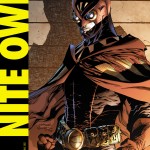 I frankly admit, up until a few years ago I was never much of a comic book kind of person. That is to say, I was never really familiar with any comic book at all; maybe because (and this is the stereotypical reason) I am a girl, or maybe because comic books were far from being popular among my family and friends; or maybe both. Whatever the reason, however, the point is, a couple of years ago I happened to come across Alan Moore and Dave Gibbons’s graphic novel Watchmen (1986), thanks to one of my new acquaintances – and the ice simply broke: Watchmen immediately engaged my interest and seemed worth digging myself into.
I frankly admit, up until a few years ago I was never much of a comic book kind of person. That is to say, I was never really familiar with any comic book at all; maybe because (and this is the stereotypical reason) I am a girl, or maybe because comic books were far from being popular among my family and friends; or maybe both. Whatever the reason, however, the point is, a couple of years ago I happened to come across Alan Moore and Dave Gibbons’s graphic novel Watchmen (1986), thanks to one of my new acquaintances – and the ice simply broke: Watchmen immediately engaged my interest and seemed worth digging myself into.
But what makes Watchmen so gripping to the audiences even today, having been released almost three decades ago? This I cannot tell – what I can tell is only what makes this graphic novel so intriguing in my perspective. In what follows, I would like to enumerate some of the innumerable issues and questions that may arise when reading Watchmen, and, at the same time, make reading this particular comic book a one-of-a-kind experience.

First and foremost, what may be the most striking attribute of Watchmen is the counterfactual nature of its narrative: it mixes historical facts with elements of fiction, and thus introduces an alternate reality in the US during the Cold War. Nevertheless, not only does the story explore an alternative contemporary history, but it also plays with past history (through the use of various flashbacks and excerpts from different writings) as it explores the question of what might have happened if an omnipotent super hero (Dr Manhattan) had existed during the Vietnam War.
Another of the most significant features of this graphic novel is how it makes use of the more traditional forms of text within the visual narrative: it mingles academic essays, official documents, correspondences, newspaper articles, cut-outs and reports with the comic book form, including a comic within the comic (a pirate story). In this way, not only does the author of Watchmen make the story appear to be more factual, but he also reminds us of how we collect pieces of information and create our own personal image of reality based on the myriads of sources that surround us.
 Last, but not least, the graphic novel also raises the evergreen question of the relativity of ethics through the complex, often (seemingly) self-contradictory nature of the characters. For instance, how can Ozymandias create a plan to bring world peace by killing millions of innocent people? Or, why does Rorschach still fight against crime despite having lost faith in humanity? Or, is Dr Manhattan any better than Rorschach who seems to be the antihero of the story? And we could go on.
Last, but not least, the graphic novel also raises the evergreen question of the relativity of ethics through the complex, often (seemingly) self-contradictory nature of the characters. For instance, how can Ozymandias create a plan to bring world peace by killing millions of innocent people? Or, why does Rorschach still fight against crime despite having lost faith in humanity? Or, is Dr Manhattan any better than Rorschach who seems to be the antihero of the story? And we could go on.
To conclude, not only does Alan Moore and Dave Gibbons’s Watchmen play with fiction and reality or traditional text and comics, but it also addresses a vast number of compelling moral (and philosophical) questions to its audience. Obviously, Watchmen is not at all a light reading; with every reading it raises new questions and thus invites the reader to challenge his views and opinions again and again.
Sources:
1.http://www.dvdsreleasedates.com/ 2. http://wallpaperswa.com/ 3. http://www.vorterix.com/ 4. http://apeday.blogspot.hu

